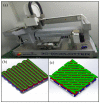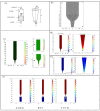Research on Cartilage 3D Printing Technology Based on SA-GA-HA
- PMID: 37570016
- PMCID: PMC10419889
- DOI: 10.3390/ma16155312
Research on Cartilage 3D Printing Technology Based on SA-GA-HA
Abstract
Cartilage damage is difficult to heal and poses a serious problem to human health as it can lead to osteoarthritis. In this work, we explore the application of biological 3D printing to manufacture new cartilage scaffolds to promote cartilage regeneration. The hydrogel made by mixing sodium alginate (SA) and gelatin (GA) has high biocompatibility, but its mechanical properties are poor. The addition of hydroxyapatite (HA) can enhance its mechanical properties. In this paper, the preparation scheme of the SA-GA-HA composite hydrogel cartilage scaffold was explored, the scaffolds prepared with different concentrations were compared, and better formulations were obtained for printing and testing. Mathematical modeling of the printing process of the bracket, simulation analysis of the printing process based on the mathematical model, and adjustment of actual printing parameters based on the results of the simulation were performed. The cartilage scaffold, which was printed using Bioplotter 3D printer, exhibited useful mechanical properties suitable for practical needs. In addition, ATDC-5 cells were seeded on the cartilage scaffolds and the cell survival rate was found to be higher after one week. The findings demonstrated that the fabricated chondrocyte scaffolds had better mechanical properties and biocompatibility, providing a new scaffold strategy for cartilage tissue regeneration.
Keywords: 3D bioprinting; additive manufacturing; cartilage regeneration; cartilage tissue engineering scaffold; finite element method.
Conflict of interest statement
The authors declare no conflict of interest.
Figures







Similar articles
-
3D Printed Chitosan Composite Scaffold for Chondrocytes Differentiation.Curr Med Imaging. 2021;17(7):832-842. doi: 10.2174/1573405616666201217112939. Curr Med Imaging. 2021. PMID: 33334294
-
Polyethylene glycol diacrylate scaffold filled with cell-laden methacrylamide gelatin/alginate hydrogels used for cartilage repair.J Biomater Appl. 2022 Jan;36(6):1019-1032. doi: 10.1177/08853282211044853. Epub 2021 Oct 4. J Biomater Appl. 2022. PMID: 34605703
-
Lyophilized Scaffolds Fabricated from 3D-Printed Photocurable Natural Hydrogel for Cartilage Regeneration.ACS Appl Mater Interfaces. 2018 Sep 19;10(37):31704-31715. doi: 10.1021/acsami.8b10926. Epub 2018 Sep 10. ACS Appl Mater Interfaces. 2018. PMID: 30157627
-
Hydrogel-Based 3D Bioprinting for Bone and Cartilage Tissue Engineering.Biotechnol J. 2020 Dec;15(12):e2000095. doi: 10.1002/biot.202000095. Epub 2020 Sep 25. Biotechnol J. 2020. PMID: 32869529 Review.
-
Alginate based hydrogel inks for 3D bioprinting of engineered orthopedic tissues.Carbohydr Polym. 2022 Nov 15;296:119964. doi: 10.1016/j.carbpol.2022.119964. Epub 2022 Aug 5. Carbohydr Polym. 2022. PMID: 36088004 Review.
Cited by
-
Tissue engineering and future directions in regenerative medicine for knee cartilage repair: a comprehensive review.Croat Med J. 2024 Jun 13;65(3):268-287. doi: 10.3325/cmj.2024.65.268. Croat Med J. 2024. PMID: 38868973 Free PMC article. Review.
References
-
- Chae M.P., Hunter-Smith D.J., Murphy S.V., Findlay M.W. 3d Bioprinting for Reconstructive Surgery. Woodhead Publishing; Sawston, UK: 2018. 15—3D bioprinting adipose tissue for breast reconstruction; pp. 305–353. - DOI
-
- Yang Q., Peng J., Lu S.-B., Guo Q.-Y., Zhao B., Zhang L., Wang A.-Y., Xu W.-J., Xia Q., Ma X.-L., et al. Evaluation of an extracellular matrix-derived acellular biphasic scaffold/cell construct in the repair of a large articular high-load-bearing osteochondral defect in a canine model. Chin. Med. J. 2011;124:3930–3938. doi: 10.3760/cma.j.issn.0366-6999.2011.23.018. - DOI - PubMed
Grants and funding
- GZKF-202204/State Key Laboratory of Fluid Power and Mechatronic Systems
- GK229909299001-403/Basic scientific research project of provincial universities of Hangzhou Dianzi University
- Y22E055902/Zhejiang Provincial Natural Science Foundation of China
- 3DL202105/Open Foundation of the State Key Laboratory of Fluid Power and Mechatronic Systems
LinkOut - more resources
Full Text Sources
Research Materials

